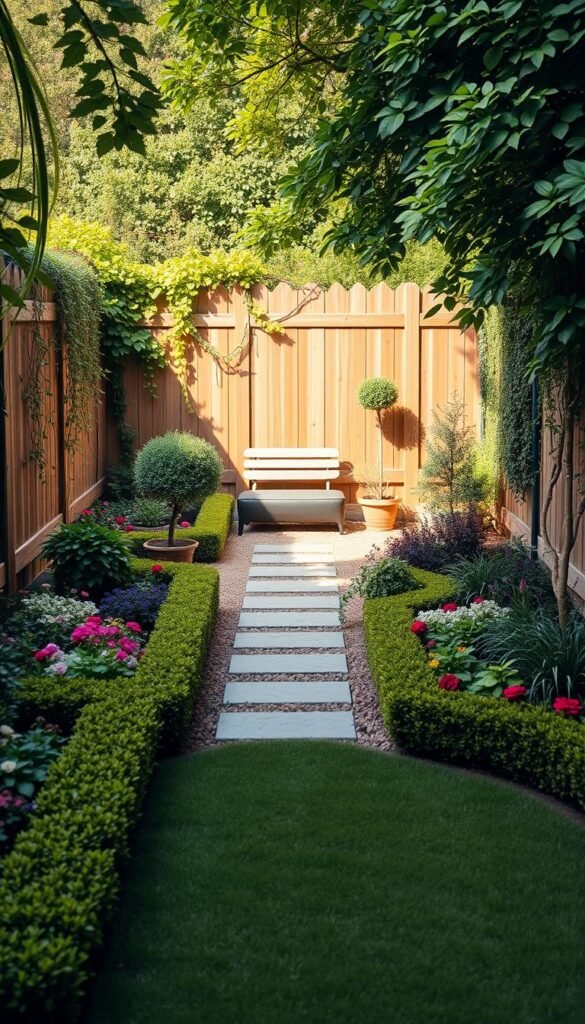Limited outdoor space doesn’t mean sacrificing style or function. With thoughtful planning, even compact areas can become inviting retreats that maximize every square foot. This guide reveals how to create visually appealing spaces that feel larger while serving your practical needs.
Start by choosing cohesive color schemes and plants with long bloom cycles. These choices create harmony and reduce visual clutter. Vertical arrangements, like wall-mounted planters, draw the eye upward—instantly making your area appear more spacious.
Budget-friendly swaps play a huge role. Gravel pathways, for example, offer texture while freeing up planting space compared to traditional lawns. Explore creative gardening ideas like foldable furniture or mobile herb carts to add flexibility without permanent installations.
Professional designers often use repetition—repeating plant shapes or container styles—to build rhythm. Pair this with bold focal points, like a striking sculpture or water feature, to guide attention and enhance depth. These tricks work together to transform cramped corners into destinations worth enjoying.
You’ll learn how balancing hardscaping with greenery creates ideal proportions. Whether you’re crafting a cozy reading nook or an entertainment zone, prioritizing functionality first ensures your layout grows with your lifestyle. Let’s turn your outdoor challenges into opportunities!
Recognizing Your Garden’s Unique Potential
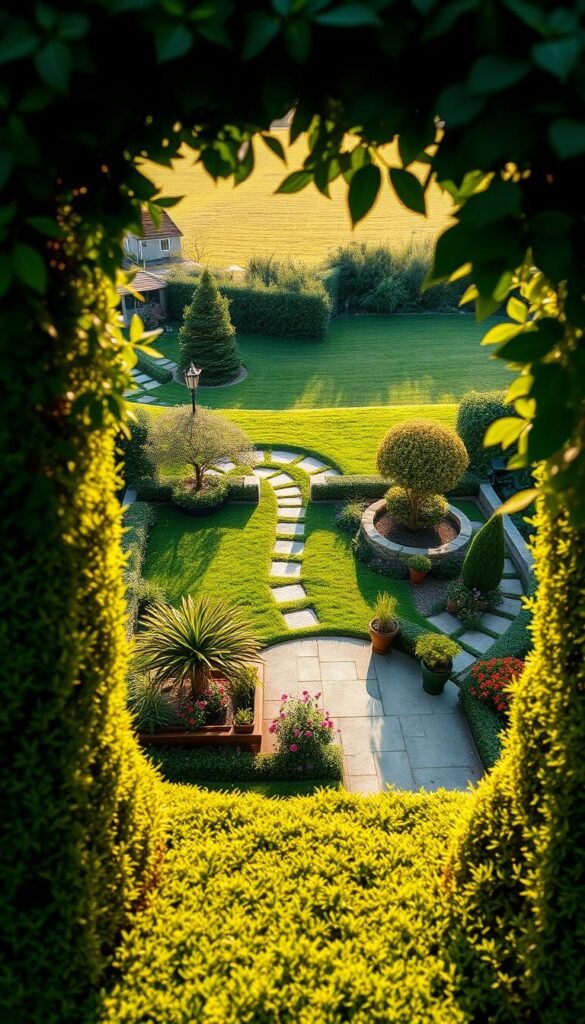
Your outdoor area holds hidden opportunities—if you know where to look. Start by embracing its quirks rather than fighting them. A narrow side yard could become a fragrant herb corridor, while that awkward corner might host a bubbling fountain.
Assessing Available Space and Layout
Grab a tape measure and sketchpad. Document every inch—paths, slopes, and existing plants. Notice where sunlight lingers longest and where puddles form after rain. These observations become your blueprint for success.
One landscaper wisely notes: “The best designs work with nature, not against it.” Use that sunny patch for veggies or flowers. Turn damp areas into lush fern groves. Your garden’s natural rhythms guide smarter choices.
Identifying Your Priorities
Make two lists: must-haves and nice-to-haves. Does your family need dining space more than a fire pit? Should storage beat decorative statues? Rank these honestly—you can’t have it all in tight quarters.
Balance beauty with purpose. A bench that doubles as storage saves space. Vertical planters add greenery without eating floor area. For inspiration on blending form and function, explore how to elevate your garden’s visual appeal while maintaining practicality.
Leave room to grow—literally. Maybe you’ll want raised beds next year or a play zone for future pets. Smart planning today means fewer headaches tomorrow. Your outdoor oasis should evolve as seamlessly as the seasons.
Smart Small Garden Design Ideas with Efficient Layouts
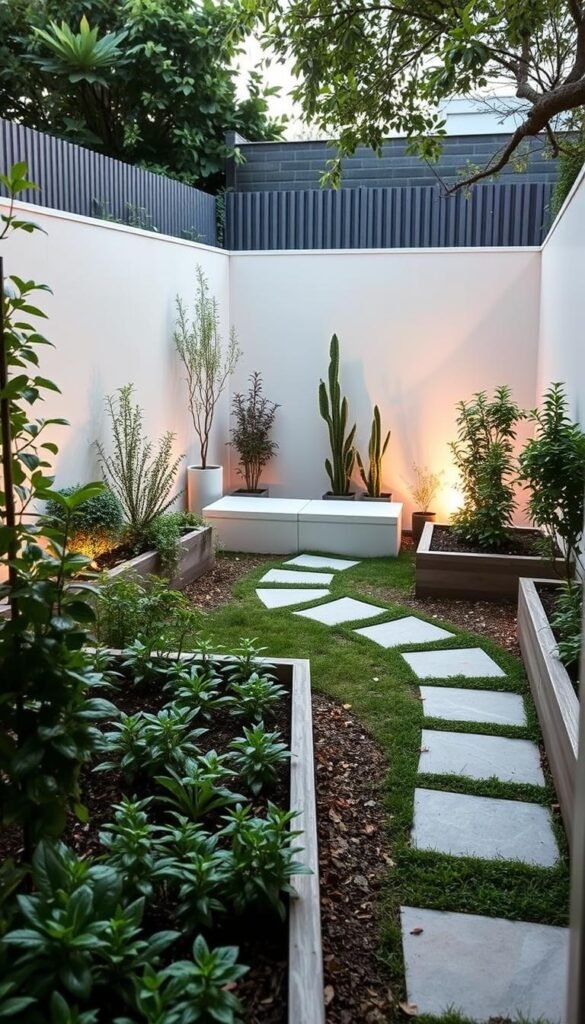
Transforming tight outdoor spots requires clever strategies that prioritize both beauty and usability. The secret lies in balancing living elements with structural foundations—a approach professionals call the 50/50 golden ratio. Half greenery or furniture, half hard surfaces like gravel or decking creates harmony while preventing clutter.
Start by dividing your area into invisible zones. A cozy reading corner can share ground with dining space when you use contrasting textures—think soft grass underfoot near smooth stone pavers. One landscape architect shares: “Multipurpose layouts thrive through visual cues rather than physical dividers.”
Elevate your strategy with these tips:
- Layer tall planters behind low benches to create depth
- Angle seating areas diagonally to expand sightlines
- Use oval-shaped paths to soften edges and improve flow
Position larger items like storage benches along perimeter walls to maintain open sightlines. This trick keeps the center area feeling airy while providing hidden utility. For those working with challenging dimensions, our guide on how to maximize your garden’s potential offers tailored solutions.
Remember: strategic vertical elements draw eyes upward, making ceilings feel higher. Hang trailing plants above eye level or install slim shelving units against fences. These moves add personality without shrinking your footprint.
Creating a Functional Outdoor Layout
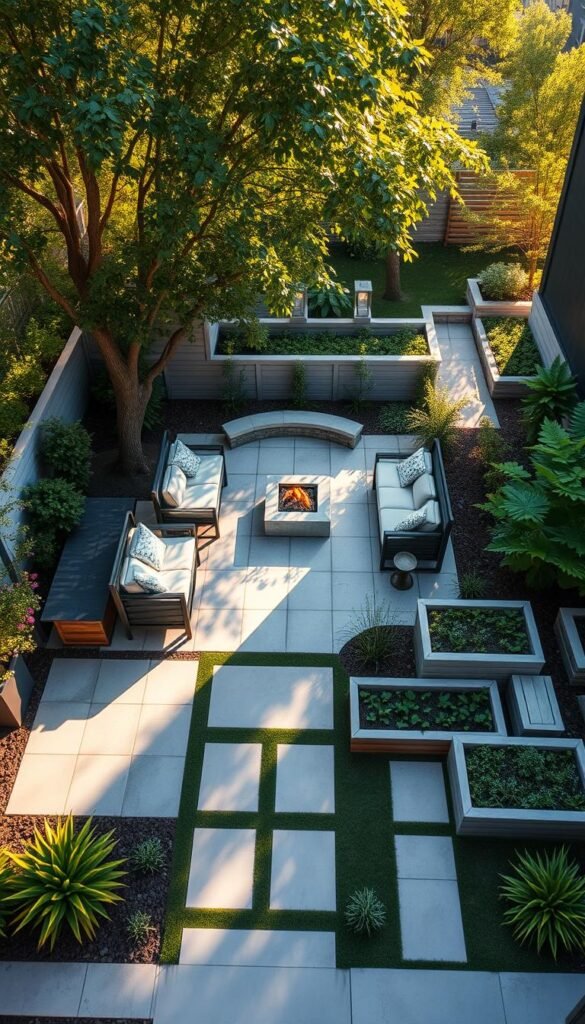
Your compact yard can become a multitasking marvel through intentional zoning. By mapping out how you actually use your area—not just how you imagine using it—you craft a layout that breathes life into every corner.
Defining Zones for Activity and Relaxation
Think of your outdoor space as a home with rooms. A low boxwood hedge can whisper “dining area,” while a raised deck platform says “sunbathing spot.” One designer shares: “Subtle shifts in materials signal new purposes—try gravel under lounge chairs and smooth stone near the grill.”
Portable elements let spaces evolve. Roll out a patterned rug for evening gatherings, then tuck it away to reclaim floor space. Potted palms make excellent room dividers that won’t block light or views.
Ensuring Smooth Traffic Flow
Watch where feet naturally travel. That worn path from the back door to the shed? Widen it with stepping stones. Curved walkways feel more spacious than straight lines—they slow movement and create discovery moments.
Keep primary routes at least 3 feet wide. Store tools in slim vertical cabinets along walls, and angle seating to face focal points like water features. For clever small backyard ideas, consider fold-down tables that disappear when not hosting dinners.
Remember: zones should connect through shared colors or repeating plants. A trailing ivy on your dining pergola might mirror the one framing your reading nook. These threads weave separate areas into one harmonious retreat.
Maximizing Space with Vertical Gardening
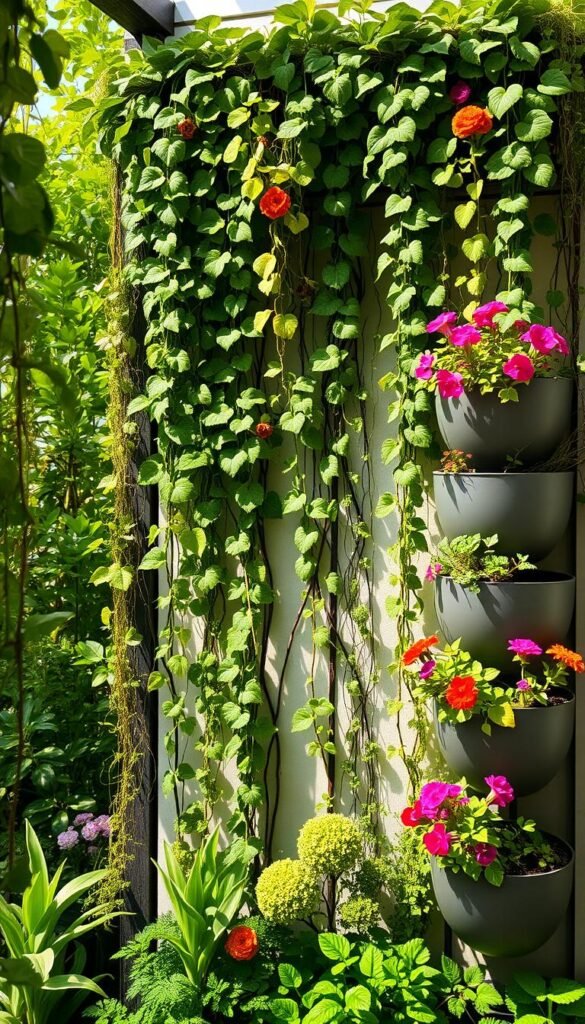
Unlock hidden growing potential by looking upward in your garden. Vertical arrangements let you triple planting areas while keeping pathways and seating zones intact. This approach turns underused walls and fences into vibrant displays that feel intentional, not cramped.
Utilizing Hanging Baskets and Planters
Hanging containers add instant charm to sheds, pergolas, or blank walls. Mix trailing lobelia with edible strawberries for a treat that’s both pretty and practical. One gardener swears by their versatility: “I grow thyme and oregano in my kitchen-facing planters—fresh herbs are always within reach.”
Rotate seasonal blooms like petunias in summer and pansies in cooler months. Use lightweight coco liners to reduce strain on hooks, and water daily during heatwaves.
Installing Green Walls and Trellises
Turn privacy screens into living art with modular wall systems. These DIY-friendly panels support succulents, ferns, or even compact veggies like cherry tomatoes. Secure them to sturdy surfaces using rust-proof brackets—south-facing walls need drought-tolerant species.
Trellises offer climbing support while adding architectural interest. Place them strategically to block unsightly views or frame desirable ones. Pair with weather-resistant twine for easy vine training.
Selecting Climbing Plants for Boundaries
Choose fast-growers like morning glory for quick coverage or honeysuckle for fragrant blooms. Clematis thrives in partial sun, while Boston ivy handles shaded brick walls beautifully. Ensure your selections match local growing conditions.
Maintain healthy growth by pruning regularly and checking for pests. Install horizontal wires on fences to guide tendrils upward, creating lush green barriers that save precious ground space.
Incorporating Multi-Use Garden Areas
Your outdoor space can pull double duty as both a pantry and paradise. A potager-style setup merges edible crops with ornamental plants, creating a vibrant tapestry that feeds your family and delights the senses.
Crafting Your Productive Paradise
Start by mapping sun patterns. Most vegetables and herbs need 6+ hours of direct light daily. Position taller plants like pole beans on the north side to avoid shading smaller crops. One master gardener advises: “Treat your kitchen plot like a living painting—layer colors, textures, and heights for year-round interest.”
These strategies maximize every inch:
| Plant | Companion | Benefit |
|---|---|---|
| Tomatoes | Basil | Repels pests |
| Carrots | Chives | Improves flavor |
| Lettuce | Nasturtiums | Attracts pollinators |
| Beans | Marigolds | Deters beetles |
Rotate crops seasonally. Replace spent spring peas with heat-loving okra. Tuck edible flowers like calendula between herbs—they’re pretty in salads and attract beneficial insects. For more companion planting secrets, explore our guide to ideal plant partnerships.
Keep pathways 18-24 inches wide for easy access. Use stepping stones through mint patches or thyme carpets. This ensures you can harvest rosemary without trampling nearby strawberries. Your kitchen haven becomes a feast for eyes and plate alike.
Designing with a Focal Point for Impact
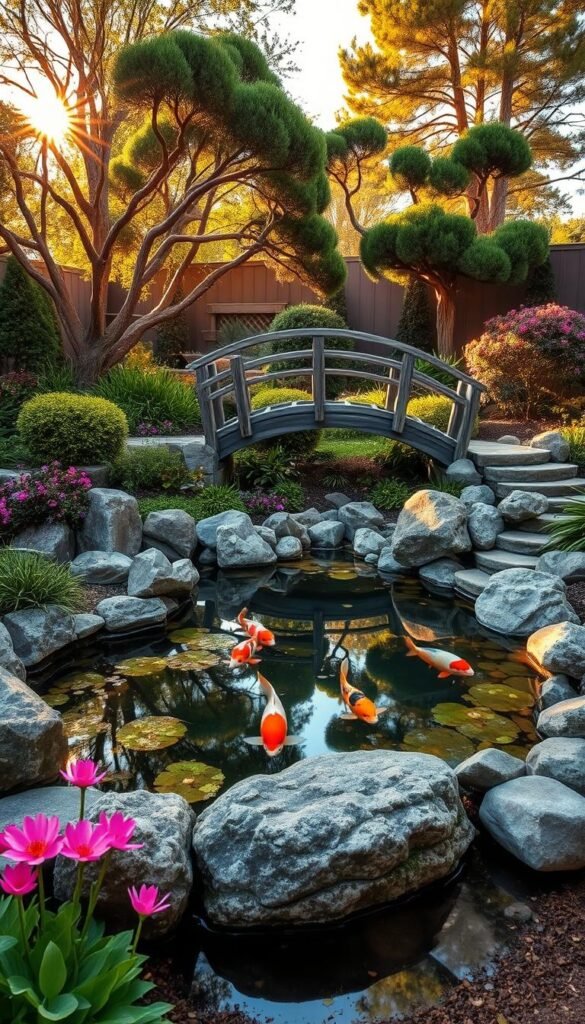
Every great garden tells a story through intentional highlights. A strong focal point acts like punctuation in this narrative—guiding movement while creating moments worth remembering. This design principle works especially well in cozy spaces where every element needs purpose.
Position your star feature where sightlines naturally converge. The end of a winding path or center of a seating area makes perfect sense. One landscape designer explains: “Your eye needs resting places. A bold container or sculptural tree gives it somewhere to land before exploring details.”
Choosing Statement Plants or Features
Go big with container choices. A single 24-inch pot filled with dwarf citrus or ornamental grasses commands attention better than six scattered seedlings. Pair it with smaller companion plants in matching hues to maintain cohesion without competition.
Consider these options for year-round appeal:
- Japanese maple with fiery autumn foliage
- Evergreen topiary forms
- Glazed ceramic urn with seasonal plant swaps
- Birdbath surrounded by creeping thyme
Architectural elements like trellis arches or stone spheres add structure during dormant seasons. Keep proportions in check—your focal piece should occupy 10-15% of visible space. For balance, surround it with simpler textures like mulch or groundcover.
Remember: focal points work best when partially revealed. Let a flowering vine partially obscure your water feature or position seating to frame your masterpiece. These subtle reveals invite exploration while maintaining visual harmony.
Using Color and Lighting to Enhance Perceived Space
Your cozy outdoor area can feel twice its size with clever color tricks and strategic illumination. By playing with visual perception and evening ambiance, you craft a retreat that looks expansive day and night.
Selecting a Cool Plant Palette
Cool-toned plants create depth. Lavender, hostas, and blue fescue grass appear to recede, making boundaries feel farther away. Place warm-colored flowers like marigolds or red begonias near seating areas—their “advancing” hues draw attention to foreground features.
One designer shares: “Purple salvia planted along fences tricks the eye into seeing extra feet of space.” Pair these with silver-leafed artemisia or dusty miller to amplify the effect. This approach keeps your greenery cohesive while stretching visual limits.
Implementing Ambient and Solar Lighting
Solar-powered stake lights line pathways without wiring hassles. Hang string lights diagonally across overhead structures to widen the perceived ceiling height. For drama, position spotlights behind textured plants—their shadows become nighttime art.
Create layers with three lighting types:
- Task lighting near grilling stations
- Accent lights highlighting specimen plants
- Soft glow lanterns for overall ambiance
Choose warm white LEDs (2700K-3000K) to protect nocturnal pollinators. These mimic moonlight while safely guiding guests through your space. Properly placed lights eliminate dark voids, making every corner feel intentional and inviting.
Utilizing Raised Beds and Containers for Efficient Planting
Elevate your growing game with raised beds and containers—tools that turn tricky spaces into productive zones. These solutions let you bypass poor soil quality while adding structure to your layout. Perfect for patios, balconies, or awkward corners, they adapt to your needs season after season.
Benefits of Raised Garden Beds
Raised garden beds simplify plant care by improving drainage and reducing weed pressure. You control the soil mix, ensuring nutrients match your plants’ needs. Their elevated design means less bending—a relief for your back during long gardening sessions.
Place these beds where sunlight shines brightest. A 4×6-foot setup can yield 16 carrots or 9 spinach plants in one square foot. For detailed guidance, explore our step-by-step raised bed guide to build your own.
Arranging Containers for Maximum Impact
Group pots on tiered stands to create lush vertical displays. Mix trailing ivy with compact herbs for texture and function. Use lightweight containers near seating areas for easy rearranging.
Rotate seasonal blooms in front-yard arrangements. Pair tall planters with low-growing succulents to maximize visual depth. With smart placement, even a few pots can feel like a curated collection.

